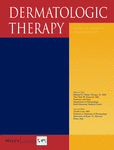Primary cutaneous anaplastic large-cell lymphoma: a case report
ABSTRACT
Primary cutaneous anaplastic large-cell lymphoma (PCALCL) is a part of the spectrum of CD30+ lymphoproliferative cutaneous processes. The characteristics include single or multifocal nodules that ulcerate as skin lesion, slow disease progression, autoregressive, and recurrent in few years. The present study report the case of a 16-year-old boy presenting PCALCL with single nodules, ulcer, keloid, and scab in his right-side face. He showed a good response to the treatment with systemic chemotherapy and dermatoplasty, and regained confidence after the appearance of recovery. There is no relapse of the primary lesion and organs involved till now. The chemotherapy combining with surgical excision and dermatoplasty is a good method for PCALCL, per the lesion biopsy and positron emission tomography-computed tomography before and after treatment.




